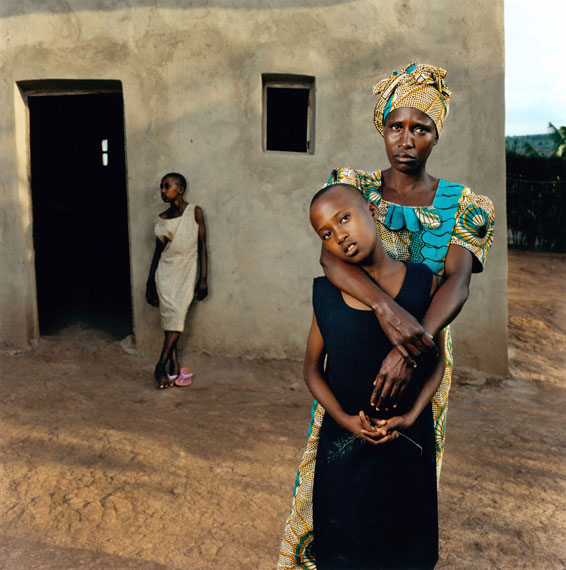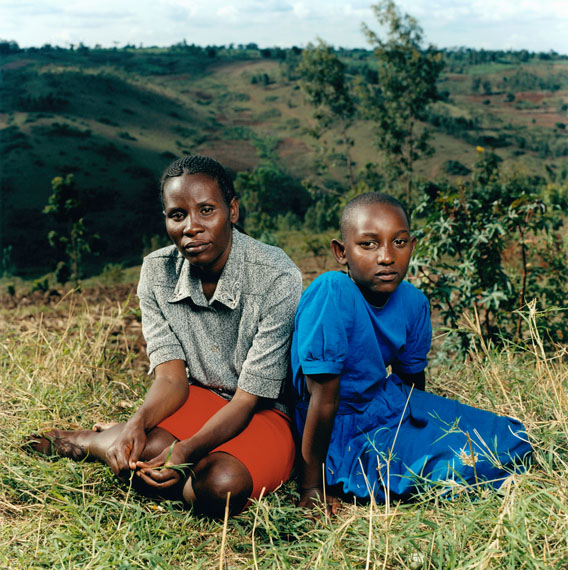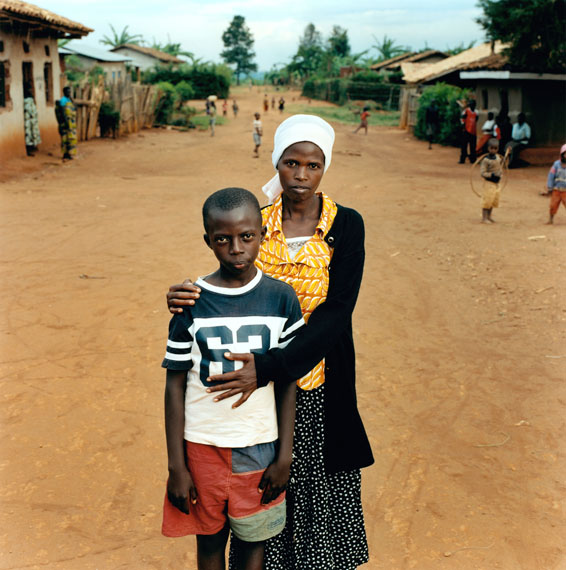
Valentine with her daughters, Amelie and Inez
That fateful day, April 9, is when they attacked my husband’s house and killed him. We had just ended our honeymoon. We had been married for three months, and I was two months pregnant, carrying a little girl. The head of the militias was ruthless and put a spear in my leg to force my legs apart. I was raped every night, and during the day, they locked me in.
When I was in a refugee camp in Congo, I gave birth to my daughter. Fortunately, she was alive. I stayed there and was raped by other men as they wished. Shortly afterward, I became pregnant again. One day, I boarded a truck that was bringing people back to Rwanda. When we arrived, I learned the news of my family: they had all been killed. I am the only survivor in my family. It took me a long time to be able to sit and talk like we are sitting here now.
I love my first daughter more because I gave birth to her as a result of love. Her father was my husband. The second girl is a result of unwanted circumstance. I never loved her father. My love is divided, but slowly, I am beginning to appreciate that the younger daughter is innocent. I love her only now that I am beginning to appreciate that she is my daughter too.
Jonathan Torgovnik »
RWANDA - INTENDED CONSEQUENCES
Athens Photo Festival 2013
Exhibition: 2 Nov – 20 Nov 2013
Fri 1 Nov 20:00
Technopolis - City of Athens
100 Pireos str, Gazi
117 42 Athina
+30 210-9210545
Mon-Fri 17-22, Sat, Sun 12-22

Justine with her daughter, Alice
We went to a church nearby because we thought that it would be safe. All of my family were killed in that church except me.
We stayed there for two weeks. On April 9, the militias took me and raped me. We were hiding in one room in the church, and the militias collected us and took us to a banana plantation where they raped me. One took me as a sex object for three days. For three days, I was his “wife,” so to speak, and when I came back after the third day, they went to steal food and property from our neighbors. I ran away to come back to the church. When I returned, I found my family dead. I was confused and stranded, but the RPF soldiers found me there and rescued me. My father and mother and all my brothers and sisters were killed. About five thousand people had taken refuge there, but less than one hundred were rescued.
I was okay until I delivered the baby I was carrying. I don’t have many problems, but my sisters left behind children. They are orphans and only have me to look after them.
But I am not strong enough or in a position to look after them. Right now, we do not have a house. If I could get shelter, I would put all these orphans together and look after them.
Over the course of three years, I traveled to Rwanda several times, to photograph, interview, and uncover more details of the heinous crimes committed against the mothers of the children in this exhibition. The mothers, many whom contracted HIV/AIDS from the militiamen that raped them, felt unable to speak about their experiences for many years, silenced by the shame of rape and having a child of militiamen who in many cases were also responsible for killing their entire families.
All the interviews in this exhibition were conducted in the privacy of the women’s homes. It was impossible to prepare myself for what I was going to hear. For most of them, this is the first time they have ever spoken out about what they experi- enced, yet with each interview, the women shared with me intimate details of their suffering, isolation, and the daily challenges they continue to face as a direct result of the violence inflicted on them.
These mothers have lived through the most severe torture any human can endure, and in the aftermath they continue to struggle against multiple levels of trauma. Unfortunately, victims of sexual violence in Congo DRC, Darfur, and around the world are facing similar challenges today. My greatest hope is that, in reading these stories and seeing the images of the women and children in this exhibition, people will be inspired to act and work toward ensuring that similar acts of violence never happen again, and that these families can have a brighter future.
The names of the women and children featured in this exhibition have been changed to protect their identities.

Stella with her son, Claude
Sometimes I forget where I am. Today we may be talking and, all of a sudden, I think I am in the forests in the Congo. Sometimes I see myself and around me, men are running, chasing me or raping me. Then, I realize I am in a normal setting. I have these hallucinations and nightmares. I have never overcome them.
The militias took us to the forest. They were very mean and started raping us one after the other. Afterward, they thought we had died and they left us there. It was a surprise if a night passed and no man raped me.
My son was born on July 7, 1995. I’ll never forget that day. I wished that he would die immediately after birth. My problem is that boy, my son. I don’t think about Rwanda often. I think about my son. He is like a tree without branches. I am alone with him. I don’t have any surviving relatives apart from my old mother. He is my life. He is the only life I have. I love him. If I didn’t have him, I don’t know what I would be. I ask myself, suppose I die now, what would happen to him? I would really be happy to have my life as it originally was before the war. Perhaps then, my son would have a future. The legacy of genocide is too much to live with.